10 Types Of Digital Marketing You Should Know – And Consider For Your Marketing Strategy
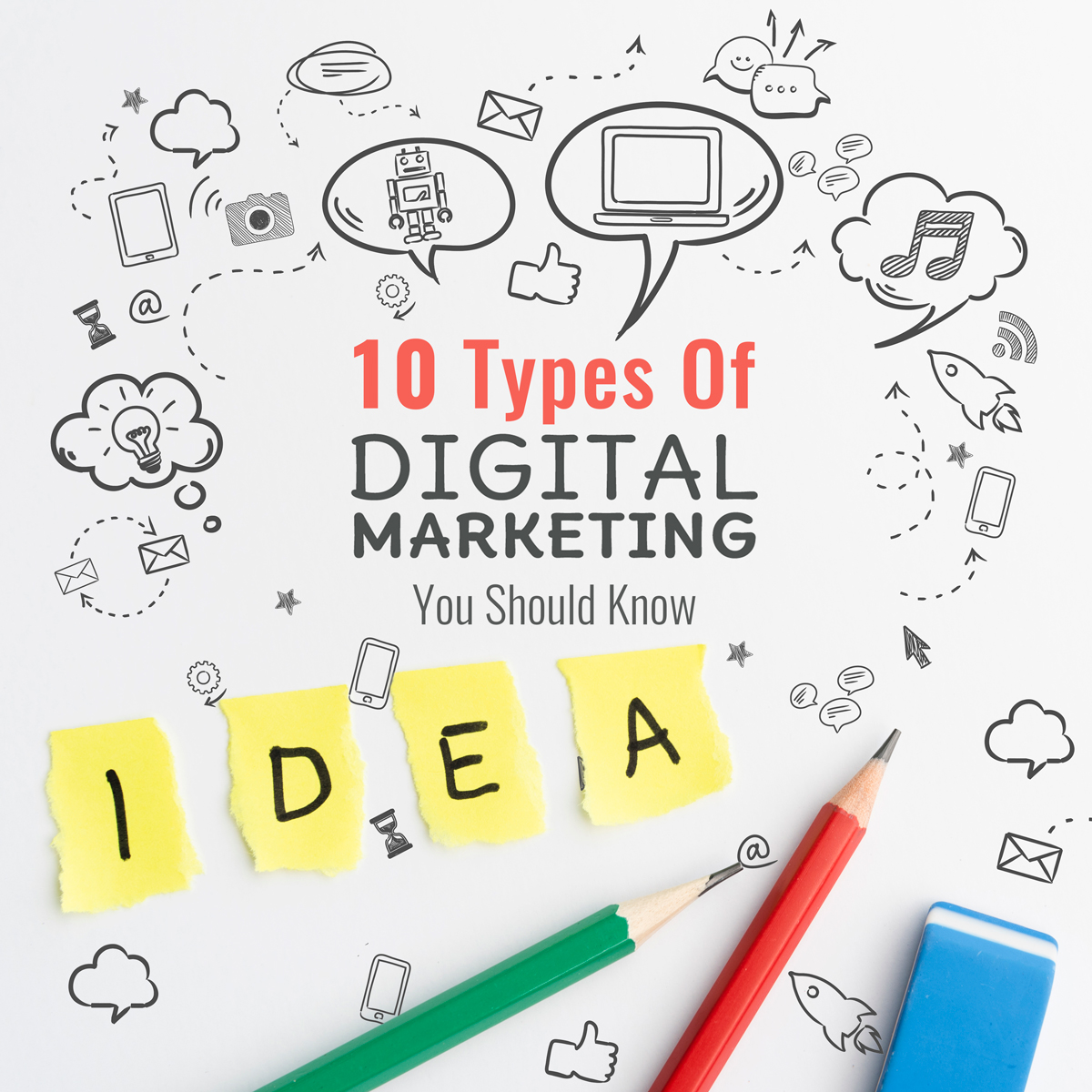
„Digital Marketing“ is one of those terms with which we all have a feeling that we know what it means, but when it comes to nailing it down we somehow get stuck. In the end, it is not clear which types of digital marketing we are talking about.
So instead of going for something soft like „it is related to internet marketing“ or „a summarizing term for all online marketing activities“ lets put it simply:
Digital Marketing are all marketing activities that use digital devices.
That includes online marketing activities – but strictly speaking, that also includes some traditional marketing activities, too. And that is good. Why? Because it would be a mistake to view online marketing activities totally detached from all other marketing activities. A great marketing campaign will combine the best of both worlds.
To give you a thorough understanding of what the term „Digital marketing“ includes, here are the 10 most important types of digital marketing. And you should make sure that you know about all of them before you decide what types of marketing you are going to include in your digital marketing strategy. And don’t just focus on one type of digital marketing. Most successful digital marketing solutions follow a multi-channel approach.
1. Social Media Marketing
The Social Ms has a strong focus on social media marketing. So that is where we are going to start our list of types of digital marketing. Social Media certainly has a rightfully earned place in this list.
Social Media Marketing is „the use of social media platforms and websites to promote a product or service.“ Source Wikipedia
That means all sharing of information and engagement with followers, fans, partners or competitors on social media platforms with the goal of promoting your products is part of digital marketing. In essence, social media marketing is the targeted use of social media conversations to increase awareness for a brand or product.
But be careful, to be successful with social media marketing you have to fully understand the one social network you want to use for your marketing. Each social network has unique features, communication best practices, and content they like. Some social networks will work great for your situation, product and content – others won’t.
Today, almost all digital marketing strategies utilize social marketing one way or the other. And don’t worry, your social media strategy does not have to use ALL available social channels or take a lot of manual action. Focusing on one or two social networks and adding marketing automation to your activity will make it much more efficient.
Example: There are endless case studies for social media marketing. But I know that most of our audience are bloggers and small business owners. That also means that most of you will not have much benefit from reading about a marketing campaign run by big brands like Coca-Cola or Microsoft. What you need are examples of people who succeeded with social media marketing on a budget with not much to go than the will to succeed and the manpower of one or two people.
That is why I will tell you a little more about our own story today:
Jonathan and I founded our first company in 2010. It was an online business but we both had not much experience with running and marketing an online business. We planned on hiring someone to help with our marketing – but the plan had a problem: We did not know what we needed to do in marketing and no real expert was available at the price we could pay.
In the end, we had to learn marketing ourselves. And we needed to learn fast and had neither time or money to fail often.
We tried a ton of things and nothing worked until we made Twitter our friend.
We were running an online publishing platform for business content and needed traffic for the content on our platform to make it more interesting for people to publish content on it. We also needed signups – meaning more people publishing content on the platform. And we needed more content published.
Twitter was the perfect social media platform for us.
What we did:
Twitter marketing usually means sharing useful information for your target audience. Out content included a ton of useful information for various target groups. We started a couple of Twitter accounts for various niches like automotive, health, tourism, finance, and so on. We shared content on these Twitter channels that matched the target group for that Twitter account. We connected to people from our target group for each of the accounts with likes, retweets, and the following of targeted people.
The results?
Most of the accounts grew a bunch of followers. Some niches were easier to access than others. We got a ton of traffic from Twitter to our content on the platform and with getting more eyes on our content other traffic sources like Google search also grew. Our platform grew to 500k pageviews per month!

But people did not just read the content. They also wanted to be part of the platform. We got new signups – 80 thousand registered users. And w got people to publish content on the platform: 50 thousand published articles.
The cost:
Apart from a couple of Twitter automation tools that came around 50$ per month, we did not pay for our marketing strategy. The marketing was mainly run by Jonathan and me.
What we invested were our time and workforce!
2. Content Marketing
Content marketing is the art of using storytelling and valuable information to increase brand awareness with the goal of getting your target audience to take a profitable action. Content marketing aims at building relationships with potential customers and becoming a partner rather than an advertiser. That means that content marketing is often used in inbound marketing strategies through a content strategy that focuses on providing value to the target audience with the content.

Image Source: Content Marketing Institute
If you want to know more and start with your content marketing today, check out this “Beginner’s Guide To Content Marketing!”
Content Marketing strongly relies on content distribution. Content marketing can rarely be seen totally separated from other types of digital marketing that can fill the content distribution part. For an in-depth view on the relationship between content marketing and SEO check out this article.
Example:
As with social media marketing, for content marketing, you can find an endless number of case studies and examples out there.
Companies like Hubspot grew their business based on content marketing. SAP realized as early as 2011 how powerful content marketing could be and started their SAP Business Innovation as a place to publish great stories of customer innovations with the goal to engage prospects with quality content.
But also small companies and startups can use content marketing – without the need for a huge budget. And that is why I chose Buffer as my example for content marketing.
Some of you may know the tool Buffer that lets you schedule content for the major social networks. Buffer was founded in 2010 – and its early marketing strategy was mainly based on publishing quality content. But instead of publishing all their content on their own website – or blog – they heavily engaged in guest posting.
Buffer was founded in a college in the United Kingdom by Joel Gascoigne and Leo Widrich.
Both were utterly new to marketing at that time. And like so many other small startups they failed at outreach to other blogs: Nobody wanted to write about the new tool (I can totally relate, we tried the same with our startup and failed as they did…)
The hard truth is that when you have a new product or business it is absolutely hard to get other blogs to write about you. Why should they?
Instead, Buffer started their own blog where they covered topics related to social media that were of interest to their potential customers. After publishing a ton of content on their blog they started their outreach to other blogs: Would they be interested in similar content? And yes they were!
In those early days of Buffer, Leo Widrich published around 150 guest posts. He used the gust posts not only to build links to the Buffer App and blog for more traffic from Google search. He also used the guest posting activity to build his reputation and connect to influencers and other bloggers.
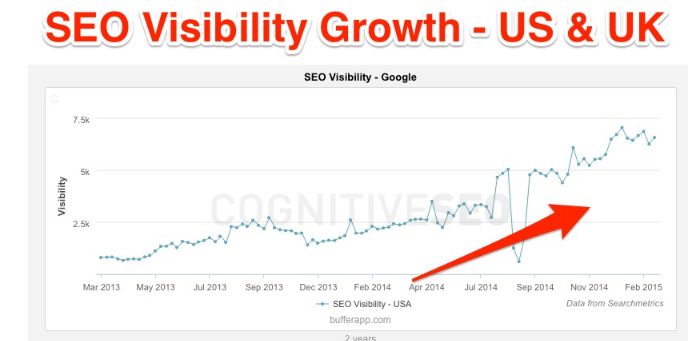
Image Source: Cognitive SEO
Today, Buffer is a multi-million dollar company. And their success is based on a content marketing campaign with a strong focus on guest posting that did not need a huge budget but was mainly run on the writing skills of one of the founders!
3. Search Engine Optimization (SEO)
SEO is the process of optimizing content or websites so that they show up in search results in search engines like Google. Search engines decide which websites to show for a search term based on keywords mentioned on the website and links that refer to this website. That means SEO has a lot to do with using the right keywords or keyphrases in the copy of a website or within the content you want to show in organic search and getting links to this website or content.

Image Source: Neil Patel
There are multiple strategies for optimizing your website(s) for search engines, and it certainly involves a lot more than shady link building. Some optimizations are accepted by Google and others are regarded rather shady and may result in Google penalizing your website. Read more about what SEO is and how it works in this article.
There is a strong connection between content, social media marketing, and SEO. The most obvious is that social media and SEO are perfect distribution channels for content.
Example: Let me tell you a story of a new website that managed to grow to 100k visitors in 12 months. Without any fancy stuff, just plain SEO work that you can do for your website too!
Start with the low hanging fruit:
Research some longtail keywords and phrases where the competition is low. How can you identify them? If the search results do not include any big-name brands from your niche, the search results don’t look overly professional and the listed content is somewhat older – that is your chance to rank your new content.
Secure a handful of links to your important pages:
This is a tough task. But it still can be done. There are some methods that you can do like ego-bait or offering a discount to readers from a blog if the blog links to your site. Or if you offer a unique service you may be able to ask service listings to add your service.
Find a link strategy:
In this example, they used high-quality photos that they offered for general usage via creative commons licenses asking people to link back to their site if they wanted to use the images. That earned them a growing number of links back to their website.
Create content with search engines in mind:
No, I am not saying they created bad SEO content. But they did their homework and found keywords that they had a chance to rank for and then created quality content for it.
If you are a blogger or content marketer and want to grow your traffic from Google search, keywords research will become your routine task.
Level up:
When you are successful with your SEO it is going to fuel itself: More traffic from search means more visitors, more visitors means more returning visitors and more links, more links means better search rankings and your traffic will increase. That is how it should work.
For Siege Media, this all played together and allowed them to reach awesome 100k visitors after just 12 months.
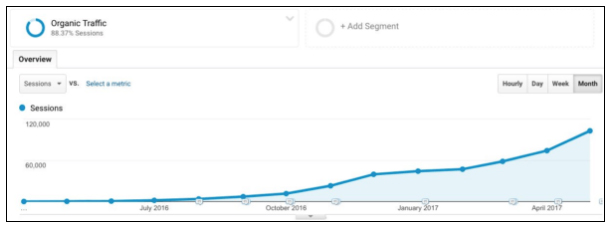
Image Source: Search Engine Land
4. Search Engine Marketing (SEM)
While SEO describes the process of getting unpaid traffic from search engines – SEM refers to using paid advertising to get traffic from search engines. The most common form of search engine marketing is probably Google Adwords for the simple reason that Google is by far the most used search engine.
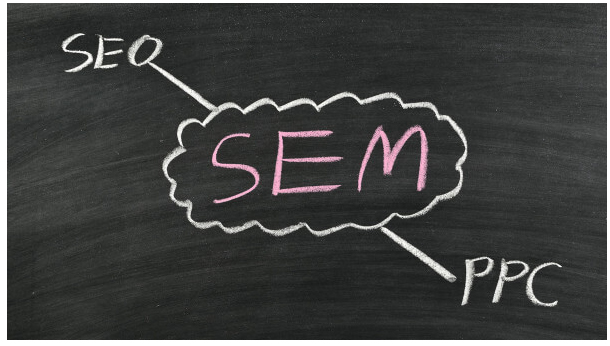
Image Source: Search Engine Land
In SEM the marketer usually pays the search engine a predefined amount of money for showing a marketing message at various places within the search results for specified keywords or phrases.
Paid search or SEM is a form of Pay-Per-Click advertising and is part of digital advertising.
5. Pay-Per-Click Advertising (PPC)
Similar to SEM other forms of PPC advertising also describe marketing methods where the marketer pays for each click on a link to a website. Apart from search engines, almost all social networks offer the opportunity for Pay Per Click advertising. These ads then appear in the feed of the targeted social media users.
Note that many of these activities cannot be clearly separated. The lines between the various types of digital (online) marketing are often blurred.
6. Affiliate Marketing
Affiliate marketing is a performance-based type of digital marketing. In contrast to PPC advertising with affiliate marketing, the advertiser does not pay for traffic but rather for conversions. The rates are usually higher but the risk on the side of the advertiser are limited since he only pays for conversions.
Affiliate marketing is popular with bloggers and high-traffic website owners who make money from selling other people’s products to their audience.
7. Email Marketing
Email marketing is one of the best converting marketing channels. By sending regular updates to your email subscribers you can build and nurture a relationship. By providing value with your email updates you can build trust – eventually, you will be able to turn a percentage of your audience into customers.

Note that email marketing is far more than buying an email list and bombarding them with promotional messages or a one-time advertising spot in someone else’s email newsletter.
The best results from email marketing will always be achieved with a list of subscribers you personally earned and nurtured. Then your email list can easily turn into your best digital marketing asset and an email campaign can drive sales.
Many articles on digital marketing stop with the above 7 types of Online digital marketing. But then we could simply name it online marketing.
Example:
The advantage of email marketing over some of the other digital marketing channels is that you own your list. While your social media audience can be gone with the suspension of your Twitter account or the shutdown of your Facebook ads account and your search traffic can be void from one day to the next if Google penalizes your website for some reason, your email subscriber list is yours.
You can decide how you treat them, how often you send emails, and what you send them.
A simple example of how to use email marketing to increase your revenues is Craghoppers email campaign to avoid shopping cart abandonment.

Craghoppers tracked people who put items in their shopping cart but never finished the purchase. To these people, they sent two emails, the first after 24 hours the second email after three days. Both emails had the purpose of re-engaging their customers and eventually inspire them to complete the purchase.
The email campaign re-engaged 56% of the recipients of the emails and inspired 30% of them to open the email and still 10% of them to complete the purchase.
That’s two very powerful emails!
You can find more on this email marketing case study here.
For your digital marketing strategy you should also know about the most important offline digital marketing types:
8. Radio advertising
You know what I am referring to, don’t you? Those breaks in your favorite music program where someone tells you what car to buy or what cleaner to use. Some of these spots can be rather annoying, a select few manage to be entertaining – at least when you hear them the first time.
There is still more to radio advertising: For instance, you can sponsor a program.
9. Television advertising
It is not dead yet: The spot that breaks up your favorite television program. While we are more and more getting used to finding ways to omit having to actually watch TV commercials there is still some marketing success in TV advertising.
In fact, some spots like the ones created for Super Bowl make it to some notable marketing fame. Some of the best Super Bowl spots even make it to social media fame and get a ton of shares that the advertisers do not have to pay for – or rather which is probably calculated into the price of advertising space for Super Bowl anyway.
What you need to keep in mind is that advertising via TV offers very limited targeting options.
Edit: Since there have been a couple of comments on this post why radio and television are included here, let me explain. There has been a huge development in radio and television in recent years and there are such things as digital radio and digital television. The options for marketing with digital adds a ton of options that former non-digital radio and television did not provide. That is the reason why I think digital radio and digital television have a rightful spot in this list of digital marketing types.
10. Mobile Phone Advertising
Of course, many of the above types of digital marketing can take place on your mobile phone. That is called mobile marketing.
You are probably using Facebook, Instagram, and Google on your mobile phone after all. But there are some other types of marketing on your mobile phone that so far would not fit into any of the mentioned categories: mobile advertising.
SMS advertising has been around for some time now.
WhatsApp as a marketing channel is growing. And with technology like Bluetooth still on the rise, the marketing and advertising options for mobile especially in local marketing have by far not yet been fully leveraged.
Final Words
It may be arguably what else belongs to „digital marketing.“ Marketing channels, skills, and digital tools are evolving. The marketing industry is not static but changing, growing, channels are coming up or dying, and skills like growth hacking live of the constant invention of new marketing tactics. Developing a successful online marketing strategy involves a lot of skills, knowledge – and even trial and error.
However, if you want to decide on your digital marketing strategy, you should be aware of these 10 – and choose the ones that you believe are best suited for your purposes.
Keep in mind that they all interact with each other and often the lines are blurred. A great marketing campaign will combine multiple digital channels. You will most likely use more than one type in your marketing strategy.
One more thing. Digital marketing will be different for larger businesses and enterprises than for small businesses and bloggers. While some campaigns may look similar, the setup, the processes, and the tools you need will be different.
reprinted by blog.thesocialms.com
9 Practical Steps For Planning a Website
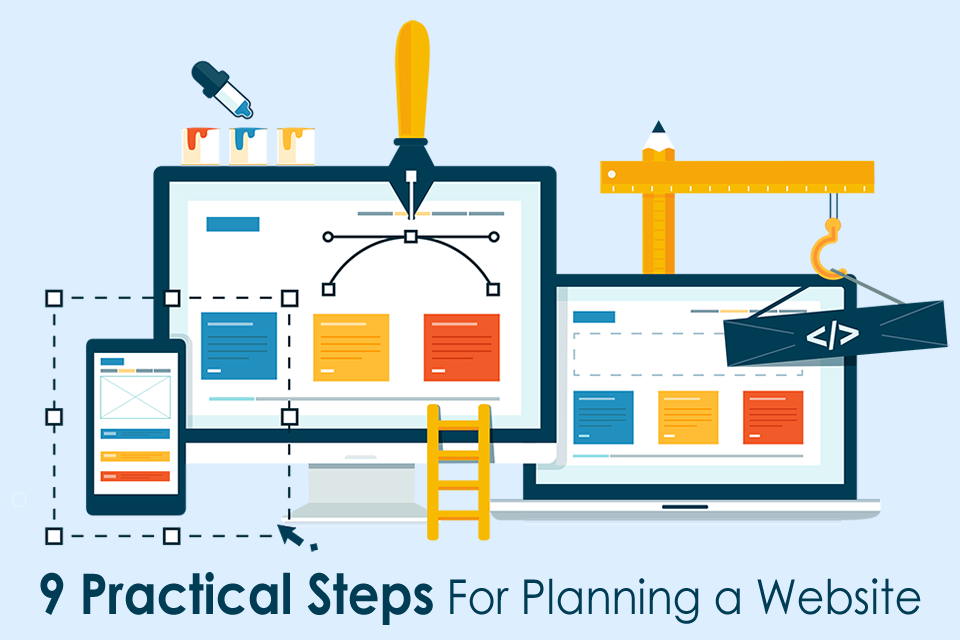
Before we get started: If you don’t have a website yet, then you can visit www.vizztech.com
1. Set your purpose and goals.
What is the purpose of your website? Is it to gain publicity for your business? To sell your inventory? To rally support behind a cause? It’s important to identify your website’s purpose, as well as your target audience. You should also define your goals. How many visitors do you expect per month? How many do you expect will sign up for your newsletter? How much in sales do you expect to make? Set measurable, specific goals for your website that are in line with your marketing goals. An analytics tool like Google Analytics will allow you to monitor your website’s performance over time.
2. Create a budget
Whether you’re an established, mid-sized organization or a fledgling start-up, you should always set a budget for your website expenses. This will probably include funds for web design, programming, and web hosting (though other expenses may apply). Research the market by shopping around and consulting with professionals. Don’t sell yourself short by comparing prices alone. What you save in money you may later pay for with a lackluster site and lots of headaches. It’s better to choose team members based on experience, insightfulness, references, and examples of work.
3. Assign roles
- Company stakeholders (owner, marketing manager, or whoever else represents a primary function of the business)
- Web developer
- Content writer and/or editor
- HTML/CSS professional
- Web and graphic designer
Make sure everyone on your team knows their role and what is expected of them, and that they stay abreast of deadlines and new developments.
4. Create a content strategy.
What kind of content will you be displaying on your website? Content is basically anything that gives your visitors information. It can include, but is not limited to:
- Blog posts
- Documents
- Video
- Pictures (such as in a gallery)
- Slideshows
- Embedded social media feeds (such as your Twitter stream or Facebook page updates)
Your content strategy is the way that you plan to present your content over time. For instance, you may want to publish two blog posts a month, and put out a free quarterly report for your subscribers to download four times a year. Since content is such a vital aspect of a website, bring in help if you need it. Hire a writer who is experienced with writing for the web, and invest in some professional looking pictures of your storefront and employees.
5. Structure your website.
Decide what pages you’ll be using and what features will be on each one. Most websites have an About and Contact page, but the pages you use should meet your business’ needs.
6. Create a mock-up
A page mock-up, also know as a wireframe, is essentially the outline of your website (with the initial design being the first draft). Usually created in Photoshop or Fireworks, you don’t have to put too much detail into your mock-up. Use placeholder text to fill pages, and don’t worry about details. This is just to give everyone an idea of what the website will look like.
If you don’t have a design program, you can also map it out with pen and paper! When you have a general feel of what you’d like, you can send it to a designer to create or do so yourself.
7. Start designing.
The importance of good web design can’t be stressed enough. Good website design includes both usability and aesthetics. An ugly website will drive away visitors, as will a website that’s difficult to navigate. Keep in mind some basic concepts of usability as you go:
- Make your navigation easy to understand and easy to find. Research shows that most users expect website navigation to be vertical and centered at the top of the page.
- Use an easy-to-read font for blocks of text. Choose a background color and text color that contrast well (Hint: No red text on a hot pink background).
- Make sure your site fits the screen. Use responsive design(or an equally effective approach) to make your website one that adapts to all screen sizes.
- Keep your website light so that it loads quickly.
- Make the company logo and tag line prominent on the page.
- Keep styles and colors consistent across the website.
- Make copy clear and concise, and put important information and features (e.g., your newsletter sign-up form) above the fold.
- Make notes about what to include in the style sheet as you design, as you want to keep style and function separate. This is important, not only to comply with web standards, but to make it easier to change something in the future if you need to.
- You should also design with the future in mind. For instance, your website may only have a few blog posts now, but what about when you have two hundred?
8. Test it out
Testing is important for getting out bugs out and catching details that you might have missed initially. Make sure your website shows up the way you want it to in all browsers, including Chrome, Firefox, Internet Explorer, and mobile web browsers like Safari and Opera Mini. Test it on your cell phone, your tablet, and your colleague’s cell phones and tablets too. You want your site to have a consistent appearance no matter what screen it shows up on. Make sure all of the links work, that the images are properly sized, and that you’ve replaced all of the placeholders with actual content. See to it that all of the forms and other input fields are working.
9. Maintain your site
Once your site is launched, the work isn’t over. A website is an ongoing entity that continuously represents your company, so maintenance is very important. Monitor your analytics software to see how your website is performing with the public. Keep an eye on metrics like your number of unique visitors, bounce rate, and which pages are most popular on your website. You might find that certain metrics are more useful to you than others, but that is information you’ll find out over time.
You should also have a plan for maintaining the website, such as who is responsible for posting new content or monitoring site security. And of course, get feedback from your users. Feedback is a valuable tool for improvement.
Planning a website ahead of time is just as important as planning anything else in business, yet this step often gets overlooked by those anxious to claim their piece of internet real estate. Taking the time to plan your website is a great investment, and it will better you chances of having a finished product that serves you well for as long as you need it.
